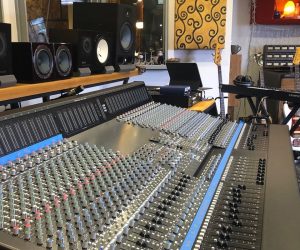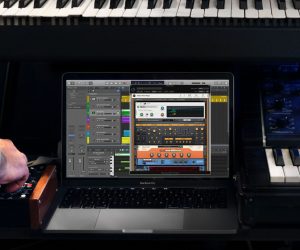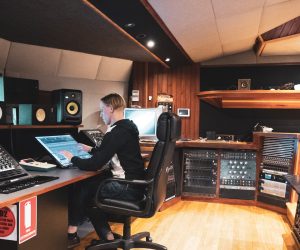
Love Hz Studios
One of Sydney’s newest and most enigmatic recording studios is the love child of two local musicians with a common bond – their love of music. Mark O’Connor investigates the realisation of a dream.
Test: Mark O’Connor
Inside a corrugated iron shed on a small industrial lot in Sydney’s Leichhardt I ponder the ’70s Mod Squad décor of my surroundings, positioned as I am on a couch of such a bright red that its very proximity acts as an antidepressant. Further splashes of colour attract my attention – the brilliant, unlikely orange of a Farfisa organ protruding from nearby shelving stacked high with drums, guitar cases, various amplifiers, other keyboards and… well, a lot of gear. And perhaps most eye-catching of all – the luminous, glowing emblematic red heart (same shade as the couch), positioned above the door to one of two control rooms, that announces Love Hz Studios.
Love Hz is the realisation of the long-held dream of two musical kindred spirits, producers and multi-instrumentalists Matt Fell and Michael Carpenter. Each has long wished to own a professional studio, but neither has wanted their ‘dream space’ to wind up becoming yet another cold, inhospitable commercial recording environment. Ideally it would have the acoustic isolation of a professional studio but the feel and look of a funky home, a musical paradise. Love Hz is that dream realised.
But in as much as the décor distinguishes it from most other commercial studios, it’s the presence of the two individuals that sets Love Hz apart – indistinguishable as they are from the studio itself as a recording apparatus. No one hires out this particular kitchen without the chefs: bring your own ingredients (songs) and whatever recipes you may have and these guys will help you whip up something that’s to your taste (Matt: “We try to achieve what’s in their heads but then go beyond it”), usually throwing in some pretty wild ingredients that maybe you hadn’t thought of before.
SOUL FOOD PRODUCTION
Matt Fell appears from out of the Love Room (officially Matt’s space) where he and Michael are co-producing a session and we adjourn to the Stagefright Room (officially Michael’s workspace) to chat. Although each has his own room, it soon becomes apparent that such is the collaborative nature of the creative process here that the demarcation lines very quickly dissolve, and the various rooms are all interactive and versatile.
TWO OF US
Mark O’Connor: Matt, can you start off by telling us how you and Michael teamed up?
Matt Fell: I actually read a review of one of Michael’s records in Mojo magazine years ago. [As well as producing, Michael is a recording artist in his own right, having released five albums in the last five years]. I emailed him soon after and he subsequently played drums on three tracks on the first Butterfly 9 record [Matt’s recording project with his wife Susie – they’ve recently released their second album]. When Michael and I first hooked up it was a real meeting of the minds – I felt like I’d found a musical soul brother, in a sense. We were both into the same sort of stuff, musically – we’re both intense Beatles fans, and Beach Boys as well – we both play most instruments, we’re both producers, and both of us had our own home studio.
Michael too acknowledges this simpatico, and observes that it has led increasingly to collaboration on projects, often in preference to working separately.
Michael Carpenter: When somebody brings a song in and plays it to us we hear the same sorts of things – we’ll look at each other and go, “Okay, let’s try this snare sound, dry… maybe this guitar through that amp…” and we’re generally thinking the same thing: there’s not a lot of explanation required. It doesn’t happen all the time of course; our production styles are in many respects very different – I come from a background of recording bands, and Matt from recording mostly solo artists. But I think I make better records with Matt, and I think he makes better records with me. We just seem to egg each other on, not in terms of one-upmanship, we just get really inspired. When we first started out here about a year and a half ago it was about 90% separate projects, 10% joint productions. But as time has passed we’ve found ourselves doing more and more projects together – I’d say around 70% of projects are now joint productions.



STAGE FRIGHT
MO’C: Michael, this room is ostensibly your control room, also serving as the main live room, yet there’s no console in here. Once you remove the mixing desk from the equation – the traditional iconic hub of the recording studio – does its absence switch you into a different headspace, make you more relaxed?
MC: Definitely. When Matt and I started talking about this place there were a couple of things that we really wanted to make sure we achieved. As you can surmise from all the guitars on the wall, the main thing we wanted was for musicians to come in here and make records – we wanted the recording process to be transparent. Technology has now reached a point where we don’t need to have consoles any more, so the ‘control room’ aspect of this room fits modestly in the corner, and the rest of the space is dedicated to music making.
People walk in and they go, “Hey, a piano with thumbtacks” or “what’s that cheesy organ in the corner, and that little dinky drum machine…what’s that? An Autoharp?” When people make records here, there are two drum kits and 10 snare drums to choose from, so they inevitably ask, “What does this one with the wooden hoops sound like?” Being surrounded by all these instruments, known and unknown, is inspiring and the psychological aspect of that is that one can imagine sounds here that weren’t thought about before; there’s a broader palette of colours to choose from. And whoever’s in here can sit down at or pick up any instrument and make music straight away and record it. There’s not a lot of time spent getting a sound, it’s literally a two-minute process between having the idea and hearing it, so you can afford to experiment.
MF: And the thing about this studio is that, having both arrived at record production from a musical background – playing in bands, doing sessions and having our own home studios – we wanted to create a space here that kept that home studio vibe, but was on a professional level. It’s like the ultimate bedroom studio – but soundproofed and air-conditioned. I love big expensive studios and I love the idea of recording in them, but it can be a frustrating experience when you want to put a drum track down and it takes three hours to get a sound – just to do the simplest thing. And that wasted time kills creativity. Here we’ve got it down to the point where if someone wants to do a drum track then hopefully in half an hour at the most we’re making music. If you want to do a bass part it takes five seconds and everything’s ready to go. That to me is how recording should be – there’s no point sitting around for three hours when you want to be creating. Obviously we make adjustments according to the song but everything’s always plugged in and connected and we’ve got everything going into the patchbay – there’s always a microphone on the Leslie cabinet, on the guitar amp, in the vocal booth, two mics permanently on the piano. Clients will often come in here with their preconceived ideas but then they look around and see an electric sitar on the wall and think “Hang on…let’s try that,” and all of a sudden the parameters have expanded.
HERE, THERE & EVERYWHERE
As we speak I sit on a couch next to a 1966 Ludwig ‘Ringo’ drumkit, permanently miked up and ready to roll. The drummer in me (there’s a drummer in everyone) is very tempted to sit down and play. There is certainly a ‘kid in a candy shop’ dynamic here for a musician. The wall behind me is festooned with an eye-popping array of stringed instruments: guitars, mandolins and banjos, while elsewhere the wall space accommodates two organs: one a Hammond and the other, according to Michael, “is cheesy but it gets used heaps ’cause it’s got really quirky sounds.” There are two pianos – one of which has recently been converted into a tack piano by attaching thumbtacks to the hammers. The exotic looking instrument lying on top of it is an Autoharp. Over in Matt’s Love Room the instrumental treasure trove continues with “a whole bunch of stuff that I collected on the road” (Matt was a notoriously avid scourer of small country town pawn shops and auctions during his touring days). In fact, a couple of the keyboards are so exotic in appearance that one assumes they perform a purely ornamental role, but Matt insists they are fully functional – though smoke was recently seen issuing from the Farfisa, hence its consignment to the shelves outside. Perhaps the object of most affection is the toy-like Optigan, for which he successfully bid on eBay – “I spent more money driving down to Melbourne to collect it than I did buying it,” he explains with a grin. With unbridled enthusiasm Matt continues: “The sounds on an Optigan are all loops, they’re on disks (resembling floppy black 78 records). It’s different to a Mellotron, which uses a recording of someone playing a note for seven seconds and then runs out – it doesn’t loop. With the Optigan, every sound is looped and as a result there are no sounds that have any attack on them. Every sound is like a French horn or an organ – a continuous sound – and each disk has four or five weird drum loops.”


Love Hz Studios has a good mix of modern and vintage outboard, and an instrument for all occasions – but sometimes choosing one can take all day!
WITH A LITTLE HELP FROM OUR FRIENDS
MO’C: You essentially have two control rooms – Matt in the Love Room and Michael in the Stagefright Room – though with a considerable degree of interchangeability, and a vocal booth joining the two at the bottom of what seems like a U-shape. How did you arrive at this design, and to what extent did you factor in the potential for collaboration?
MF: We were so naïve. When I think back on it, I can’t believe how little I knew about what it takes to build a studio. We found the space, and I tried to draw up my own plans for what I thought would work. We always had the idea of being able to keep our own separate spaces but also be able to be connected – to have two separate studios or one, depending on what we were working on. It took us forever to find the right person to design it, which ended up being Richard Priddle (who contributed to the design of Sony, Alberts, Milk Bar – now Electric Avenue – and BJB studios). Richard was, in fact, recommended to us by Rick O’Neil and Andy Stewart from AudioTechnology. After trying for months to do my own rough plan, he came in here for 10 minutes and said, “It can’t be done, but I’ll give you a call anyway”. He went away and worked on it over the weekend and by the Monday had drawn designs for the studio and worked out a way we could do it within the budget – the amount of money we had, dictated the dimensions of the place.
Basically those plans were pretty much exactly what we’ve got now, based on his 10-minute visit. He wanted to know what we did, how we worked, what we were into musically, how we operated – all of which totally influenced the design he came up with. For example, there are sight lines from every room into every other room. Seeing the way we worked together, he knew it all had to be connected and he designed it with that in mind. He really got where we were coming from. And there’s some future-proofing too, because eventually we’re thinking of building another live room – so there’s space for us to expand.
Mostly we use the Stagefright Room to record drums, piano and percussion, and the vocal booth for vocals and guitar amps. It’s very flexible. The wiring and patching is such that everything’s connected, so that you can basically put anything anywhere and record it. The Stagefright Room was designed to serve as a drum room as well as Michael’s control room. While big drum rooms can be great, it can get a bit hard to contain the sound sometimes – they can be a bit overblown and unfocussed. This room [Stagefright Room] to me is small enough that you can maintain the dynamics and the focus of the drums, but it’s just big enough so that you can get a bit of ambience in the recordings if needs be. We’ve got spots in here where we know the room mics sound really good – when we compress the hell out of them and it sounds like a Led Zeppelin record. Or you can get a more intimate sound where the drums sound really soft and tight and close. The surface areas are conducive to that – all credit to Richard Priddle.
MC: Sometimes we have bands that all want to play together in the same room and don’t care about spill and we can set everything up in here and it sounds great. And if they want separation that can be achieved too – every room has its own patchbay, including the hallway leading into Matt’s room.


MIXING – CONSOLE YOURSELF
MF: We mix purely in ProTools – it’s all internal – but importantly we don’t rely heavily on the mixing stage to get our sounds. We have lot of good outboard gear so everything that gets recorded here goes through something nice. We’ve got Neve preamps, really nice Quad Eights, some beautiful old Telefunken EQs, a Distressor and a Urei 1176 compressor. Wherever drums are being recorded, we just wheel the rack in. I’m a great believer in recording the sound onto ProTools the way you want to hear it when it’s mixed. To me it’s really important to be able to record the sound that I want to hear, rather than try and achieve it later using plug-ins. Obviously we do use plug-ins, but if you get your sounds as close as you can when you’re recording, there’s just so much less work to do during mixdown – and it sounds better as well. I enjoy mixing as I go along because I like to feel the track grow organically. Mixing in ProTools is great because a lot of the projects that are recorded here are self-funded independent projects, some of which are recorded in installments over long periods as money comes to hand. Often times people will come back months or even a year later and say, “I really liked that mix we did, but can we turn the vocal up?”. To be able to call up the old mix and make that simple change is a great way of working… and virtually impossible in the analogue domain.
Some people immediately get worried when they come in and don’t see a desk – they think you can’t mix a project in ProTools, inside the box. But you can. I’ve done internal mixes of tracks and then compared them to mixes that have been done in bigger studios – and the ones I did came out better because I knew what I wanted. It’s ultimately about the person behind the desk, and getting the right feeling for the song. I have absolutely no snobbery when it comes to gear and yet I’ve had engineers tell me to my face that you can’t make records on a 002, or you can’t mix a record in ProTools, which is rubbish. When I’m mixing I use automation to its fullest extent – really take it to extremes. I don’t use any outboard gear while mixing; it’s completely inside the box.
FINGERPRINTS
MO’C: Do you leave your own sonic imprint on projects that you produce? For example, I know you’re a fan of Jon Brion’s production, and to me he often imparts quite a distinctive flavour.
MF: I think Michael and I have very similar and yet different styles of production. In terms of leaving our fingerprints on an album, to some degree it’s inevitable, especially on records that we’re playing on. But most people want to work with you precisely because of that ‘fingerprint’ rather than in spite of it. The hardest part is trying not to repeat yourself, and that can be difficult, particularly when you’re busy – it’s often easier to do something the same way you did it last week. But we’re always trying to adopt a new approach or swap things around: trying to find new miking techniques on drums, experimenting and finding something that really works. Fingerprints are inevitable… but hey, at least they’re human.
















RESPONSES